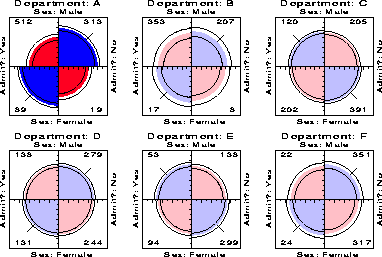Visualizing Categorical Data: fourfold
$Version: 2.0
Michael Friendly
York University
SAS/IML modules for four-fold display of 2 x 2 x k tables
The FOURFOLD program is a collection of SAS/IML modules for
constructing fourfold displays of a 2 x 2 table, or
a collection of 2 x 2 tables for multiple strata or groups.
The modules are typically loaded into the SAS/IML
workspace with the %include
statement. The required inputs
consist of the contingency table, its dimensions, the variable names,
and names for the variable levels.
These are usually specified
with SAS/IML statements, and the fourfold module is called
as follows,
proc iml;
%include iml(fourfold);
*-- specify required parameters;
dim = { ... }; *-- table dimensions;
table = { ... }; *-- contingency table;
vnames = { ... }; *-- variable names;
lnames = { ... }; *-- level names;
*-- specify desired global variables;
config = {1};
run fourfold( dim, table, vnames, lnames );
The FOURFOLD program also provides a variety of optional parameters
to be specified as global SAS/IML variables.
All of these are given default values if not specified.
Required parameters
The required parameters for the run fourfold statement are listed below.
These are positional parameters, and may be given any valid SAS name
in the PROC IML step.
- dim
- A numeric vector containing the dimensions of the contingency table.
The first two elements must be {2 2}.
- table
- A numeric matrix containing dim[1]=2 columns
and number of rows equal to the product of the remaining elements
of dim.
The table must be entered so that the first variable
varies most quickly (row-major order), and the last variable
varies most slowly, in accord with the conventions for
multiway tables used by the SAS/IML routines marg and ipf.
- vnames
- A 1 x ncol(dim)
character vector, containing the names
of the variables in the order corresponding to dim.
- lnames
- A character matrix containing the names of the categories
(levels) of the variables, whose rows correspond to dim
and vnames.
Any short
rows must be filled in with blank character strings,
because matrices in SAS/IML must have the same number of elements in
each row.
For example, for the 2 x 2 x 6 table for the Berkeley data,
the dim, vnames and lnames may be entered
as follows:
dim = {2 2 6};
vnames = {'Admit?' 'Sex' 'Department'};
lnames = {'Yes' 'No' ' ' ' ' ' ' ' ',
'Male' 'Female' ' ' ' ' ' ' ' ',
'A' 'B' 'C' 'D' 'E' 'F'};
Global input variables
The following global variables are used by the program if they have
been assigned values of the correct type (character or numeric).
Since they all have
default values, it is only necessary to specify those you wish to
change. All character-valued variables are case-insensitive.
- std
- Specifies how the 2 x 2 tables are standardized.
[Default: std='MARG'.
- MARG
- standardizes each 2 x 2 table to equal
margins, keeping the odds ratio fixed. The config
variable determines which margins are equated.
- MAX
- standardizes each table to a maximum
cell frequency of 100. This has the effect of equating the totals
in each table.
- MAXALL
- standardizes all tables so that the maximum
cell entry is 100.
- config
- specifies the margins to standardize, when std='MARG'.
config={1 2} equates both the row and column variable in
each table; config={1} equates the margin only for the column
variable in each table; config={2} equates only the row
variable.
- down
- Specifies the number of fourfold panels down each page
- across
- Specifies the number of panels across each page
- sangle
- The angle for side labels (0 | 90).
[Default: sangle=90].
- colors
- The names of two colors to use for the smaller and
larger diagonals of each 2x2 table. The positions of first color
indicate the direction of association.
[Default: colors={BLUE RED}].
- patterns
- The names of two fill patterns. For grayscale, use
patterns={SOLID SOLID} and colors={GRAYC0 GRAY80}.
[Default: patterns={SOLID SOLID}].
- alpha
- is the error rate used for confidence rings on the odds ratios.
Use alpha=0; to suppress the confidence rings.
- conf
- The type of confidence rings, either
'Individual' (for each 2 x 2 table) or 'Joint'
(for simultaneous confidence intervals covering all k 2 x 2 tables).
[Default: conf='Individual'].
- font
- A character string specifying the font used.
The default is Helvetica (font='hwpsl009') if a PostScript
driver is being used, SWISS otherwise.
- frame
- the line style for the boxed frame (0=none).
Example
proc iml;
%include iml(fourfold.sas);
*-- Berkeley Admissions data;
dim = {2 2 6};
vnames = {'Admit?' 'Sex' 'Department'};
lnames = {'Yes' 'No' ' ' ' ' ' ' ' ',
'Male' 'Female' ' ' ' ' ' ' ' ',
'A' 'B' 'C' 'D' 'E' 'F'};
table = { 512 313, 89 19,
353 207, 17 8,
120 205, 202 391,
138 279, 131 244,
53 138, 94 299,
22 351, 24 317};
std='MARG'; /* IML4FOLD, fig 3 */
alpha=.01;
patterns={solid solid};
htext = 2.4;
filltype={hls hls};
run fourfold(dim, table, vnames, lnames);

See also
agree Agreement chart for n x n table
mosaic Macro interface for mosaic displays
mosaics SAS/IML programs for mosaic displays
mosmat Macro interface for mosaic matrices
sieve Sieve diagrams for two-way tables
